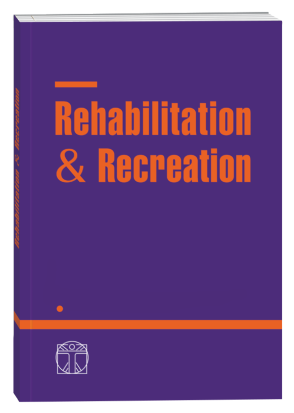ФІЗИЧНА ТЕРАПІЯ В РАЗІ ДЕФОРМАЦІЇ ХАГЛУНДА-ШИНЦА
DOI:
https://doi.org/10.32782/2522-1795.2023.17.12Ключові слова:
перебіг, деформація Хаглунда-Шинца, фізична терапія.Анотація
Мета статті – описати особливості фізичної терапії дітей та підлітків з деформацією Хаглунда- Шинца. Висвітлено фактори розвитку, а саме виявлено, що найбільш схильні до цієї недуги дівчата у віці 7–8 років, а також хлопчики у віці 9–11 років. За даними «Обласного громадського центру здоров’я» (м. Рівне, Рівненська область) у кожної 45-ої дитини віком до 16 років у анамнезі присутня деформація Хаглунда-Шинца, а отже, поширення інформації про засоби фізичної терапії як основи консервативного лікування дозволить попередити виникнення ускладнень, а заходи профілактики допоможуть попередити розвиток захворювання. Засобами фізичної терапії хворих на деформацію Хаглунда-Шинца є: комплекс терапевтичних вправ, лікувальний масаж, кінезіотейпування та фізіотерапія. Дані засоби використовуються комплексно, мають індивідуальний характер. У ході дослідження було розроблено програму терапевтичних вправ і встановлено, що ефективність даної програми становить 86,7%. Протипоказанням до виконання даного комплексу вправ є різкий біль під час ходьби. На етапі повного відновлення починають виконувати активні рухи в гомілковостопному суглобі, дозволяється ходьба на пружинних пристосуваннях, заняття на велотренажерах. Щоб деформація Хаглунда-Шинца у дітей не прогресувала, рекомендовано носіння підп’ятників. Необхідно уникати занадто великих навантажень на стопу, під якими розуміють, наприклад, стрибки, присідання, біг з особливим акцентом на п’ятку. Своєчасне застосування фізичної терапії сприяло покращенню стану пацієнтів, зокрема, зменшенню болю, припухлості та почервоніння у пацієнтів із запаленням ахіллового сухожилля, а у пацієнтів із наявним кістковим наростом – зменшенню болю під час ходьби, а також покращенню загального стану пацієнтів.
Посилання
Герасимюк Б.С. Визначення ефективності застосування ортопедичних устілок-підп’ятників в комплексі консервативного лікування хворих із ахіллобурситом. Young Science 2.0 : збірник мат. Всеукр. наук.-практ. інтернет-конф. 2020. С. 14–16.
Збірник лекцій з курсу «Фізична реабілітація та основи масажу» для підготовки бакалаврів спеціальності 014.11 Середня освіта «Фізична культура». Укладач Прокопенко Ю.С. Кременчуцький педагогічний коледж імені А.С. Макаренка. Кременчук, 2018. С. 48–82.
Лазарев І.А., Герасимюк Б.С., Мовчан О. С., Скибан М.В.. Біомеханічний аналіз поведінки структур заднього відділу стопи в акті ходьби при зап’ятковому бурситі й синдромі Haglund. Травма. 2019. № 6. С. 108–110.
Лікувальний масаж. Вакуленко Д.В., Вакуленко Л.О., Кутакова О.В., Прилуцька Г.В.. К.: Медицина, 2020. 259 с.
Нанинець В.Я., Лябах А.П. Диференційна діагностика больового синдрому в задньому відділі стопи у пацієнтів із неправильно зрощеними переломами п’яткової кістки. Вісник ортопедії, травматології та протезування. 2016. № 2. С. 53–57.
Пінчук Є.І., Покропивний О.М. Фізична реабілітація при пошкодженні ахіллового сухожилля. Актуальні проблеми клінічної та профілактичної медицини. 2018. № 2(1). С. 55–59.
Boffeli T.J., Peterson M.C. The Keck and Kelly wedge calcaneal osteotomy for Haglund's deformity: a technique for reproducible results. J Foot Ankle Surg. 2013. № 51(3). Р. 398–401.
Heneghan M.A., Pavlov H. The Haglund painful heel syndrome. Experimental investigation of cause and therapeutic implications. Clin. Orthop. 1984. № 187. Р. 228–234.
Jerosch J., Sokkar S., Dücker M., Donner A. Endoscopic calcaneoplasty (ECP) in Haglund's syndrome. Indication, surgical technique, surgical findings and results. Z Orthop Unfall. 2012. № 150(3). Р. 250-6. doi: 10.1055/s-0031-1280344.
Lui T.H., Lo C.Y., Siu Y.C. Minimally Invasive and Endoscopic Treatment of Haglund Syndrome. Foot and Ankle Clinics. 2019. № 24(3). Р. 515–531.
Nesterchuk N., Grygus I., Prusik K., Zukow W. The technique of physical rehabilitation in clubfoot. Physiotherapy Quarterly. 2019. № 27(1). Р. 25–34. URL: https://doi.org/10.5114/pq.2019.83058
##submission.downloads##
Опубліковано
Як цитувати
Номер
Розділ
Ліцензія

Ця робота ліцензується відповідно до Creative Commons Attribution-NonCommercial-NoDerivatives 4.0 International License.












